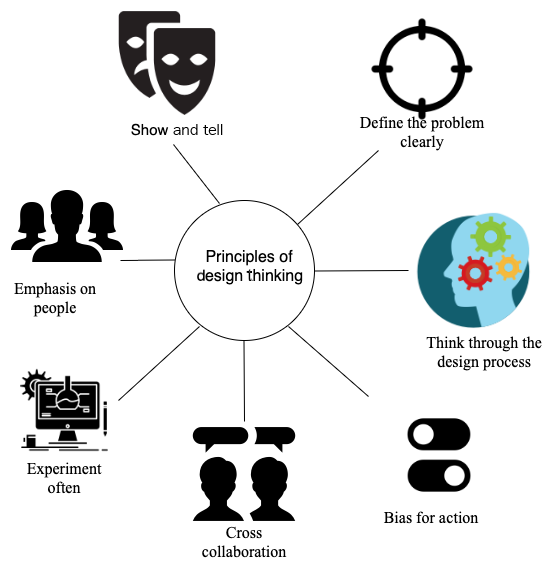A solution architect has the primary role of system design, which makes design thinking an essential skill. Design thinking is one of the most successful approaches adopted across industries to solve a challenging and unclear problem. Design thinking helps you to look at problems and solutions from a different perspective, which you might not have considered in the first instance. Design thinking is more focused on delivering results by providing a solution-based approach to solve the problem. It helps to pretty much question the problem, solution, and associated risk, to come up with the most optimized strategy.
Design thinking helps you to redefine problems in a more human-centric way by putting yourself in place of end users and customers. The following diagram illustrates the primary principles of design thinking:

The following points are some design-thinking principles:
- Emphasis on people: Collect feedback from various users and put yourself in their place to understand the problem from a different perspective.
- Cross-collaboration: Bring in people from different backgrounds to look for problems in a diversified way, and make sure solutions accommodate everyone's needs.
- Think through the design process: Understand the overall design process, with clear goals and methods.
- Show and tell: Present your thoughts in visuals so that it will be easy to grasp for everyone in the room.
- Define the problem clearly: Create a well-defined and clear vision for a given challenge, which can help others understand clearly and encourage them to contribute more.
- Experiment often: Create a prototype to understand the implementation of the idea in real-life situations. Adopt a fail-fast strategy and experiment more often.
- Bias for action: The ultimate design to deliver a solution rather than just thinking. Be proactive in pushing forward and coming up with activities that can result in a workable solution.
Design thinking has a solid foundation to apply empathy and create a holistic view of the given problem. To adopt design thinking, there is a five-phase model proposed by d.school (https://dschool.stanford.edu/resources/getting-started-with-design-thinking). They are a pioneer in teaching and applying design thinking. The following diagram illustrates the five phases of design thinking:

Design thinking is an iterative approach that needs to evolve continuously. The output from one phase can recursively be input to other phases until the solution gets solidified. A brief overview of the phases follows:
- Empathize: Empathy is the building block and foundation of design in the human context. To empathize, you should observe your user behaviors and engage with them to understand the actual issue. Try to immerse yourself in—and experience—the problem by putting yourself in the situation.
- Define: Empathizing helps to define the problem as you experience the user's needs and the problem they are facing. In the define mode, you apply your insight and define the problem clearly, which can fuel brainstorming to find an innovative yet simple solution.
- Ideate: The ideation phase is about moving from problem to solution. You work with the team to find various alternative solutions by challenging assumptions. You need to get an obvious solution out of your head and work collaboratively to find all possible solutions, which allows for innovation.
- Prototype: The prototype phase helps to convert ideas into a concrete solution. Prototyping can provide lots of learning and help to resolve disagreements by showing a proof of concept (POC). It helps to find out gaps and risks. You should build a quick prototype without lots of investment, which allows you to handle failure and increase learning.
- Test: The test phase is about getting feedback on your solution and reiterating accordingly. The test phase helps to redefine the solution and learn more about your users.
Design thinking accommodates all the phases required to come up with a logical and practical solution. You can relate the phases and principles of design thinking in your real life when designing an application architecture. There is special stress on prototyping, as that is the only way to solidify your proposal and existing solutions with data and facts. A solution architect's primary job is to understand the business concern and create a technical solution design with a prototype that the team can implement. To build a prototype, the solution architect needs to get their hands dirty and engage in coding hands-on. Let's learn more about it.
